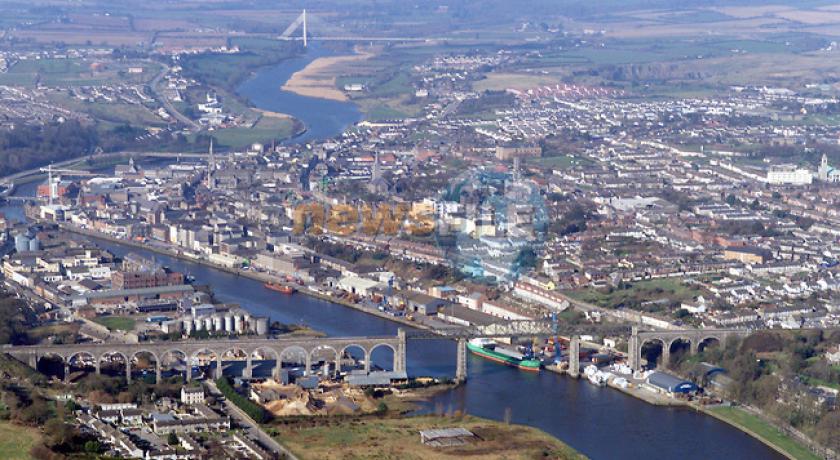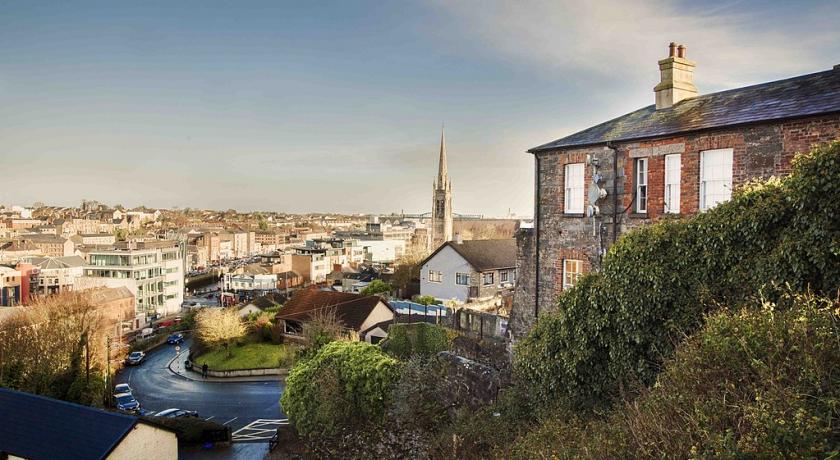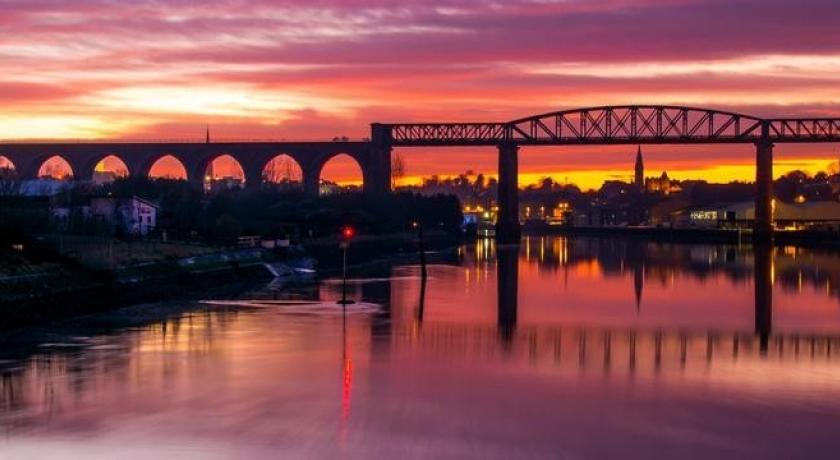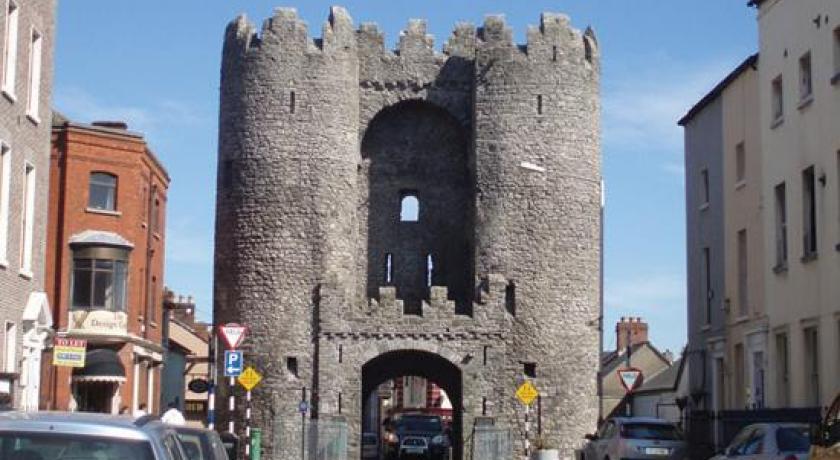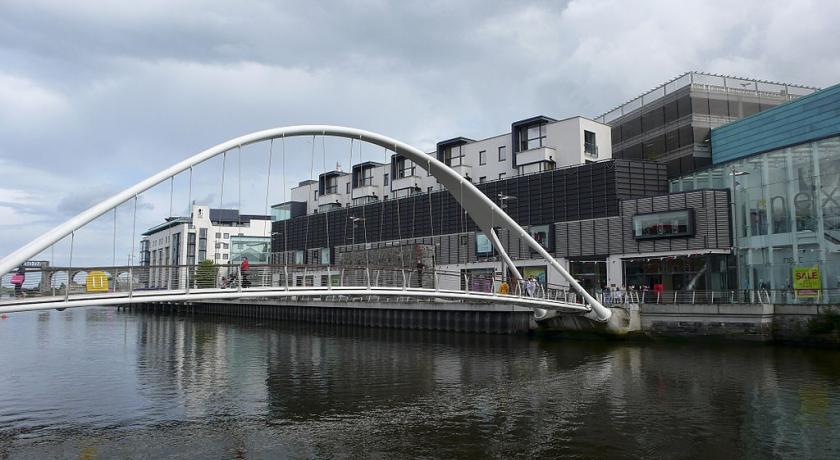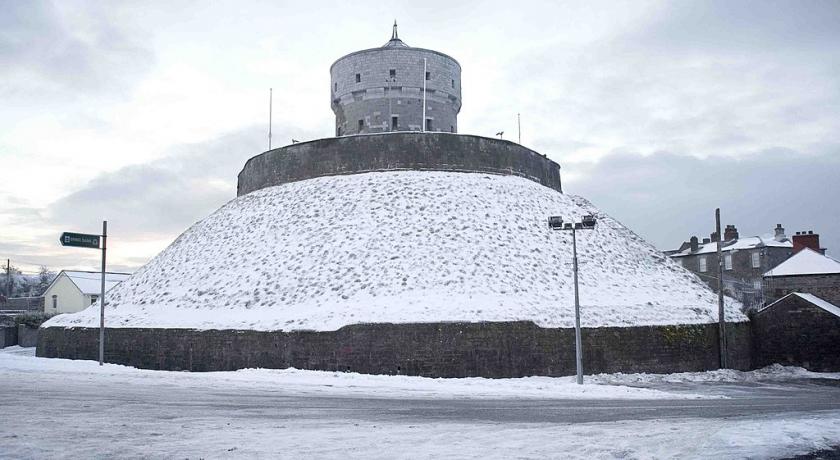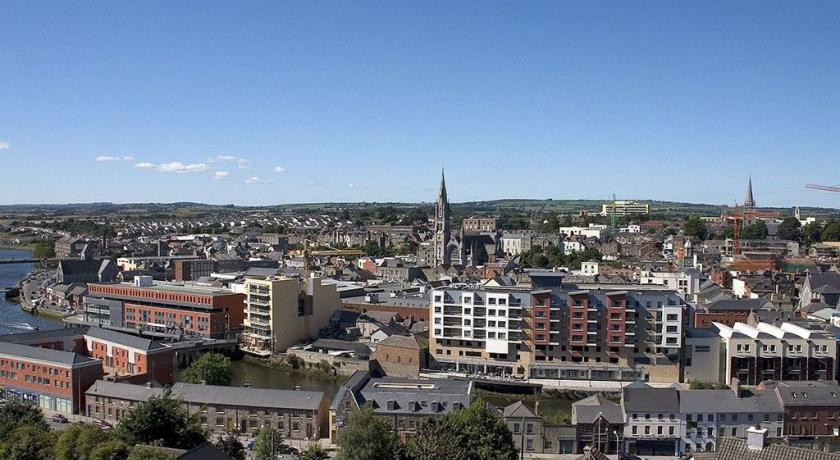Description
Drogheda (; ; Irish: Droichead Átha, meaning "bridge of the ford") is one of the oldest towns in Ireland, known for its tourism and as a centre of industry and medical care. It is located in County Louth on the Dublin-Belfast corridor on the east coast of Ireland, 49 km or 30 miles north of Dublin. It is the last bridging point on the River Boyne before it enters the Irish Sea.The UNESCO World Heritage Site of Newgrange is located 8 km to west of the town.
As the River Boyne divides the dioceses of Armagh and Meath, Drogheda was founded as two separate towns, Drogheda-in-Meath (for which a charter was granted in 1194) and Drogheda-in-Oriel (or 'Uriel') as County Louth was then known. In 1412 these two towns were united and Drogheda became a 'County Corporate', styled as 'the County of the Town of Drogheda'. Drogheda continued as a County Borough until the setting up of County Councils, through the enactment of the Local Government (Ireland) Act 1898, which saw all of Drogheda, including a large area south of the Boyne, become part of an extended County Louth. With the passing of the County of Louth and Borough of Drogheda (Boundaries) Provisional Order, 1976, County Louth again grew larger at the expense of County Meath. The boundary was further altered in 1994 by the Local Government (Boundaries) (Town Elections) Regulations 1994. The 2007–2013 Meath County Development Plan recognises the Meath environs of Drogheda as a primary growth centre on a par with Navan.
In recent years Drogheda's economy has diversified from its traditional industries, with an increasing number of people employed in the retail, services and technology sectors. The town also has a community of independent artists and musicians who have been looking to the local economy rather than Dublin for employment. Drogheda was also selected to host Fleadh Cheoil na hÉireann 2018.
Demographics
Drogheda has a hinterland of 70,000+ within a 15 kilometres (9.3 mi) radius covering County Louth and County Meath. According to the 2011 Irish Census, there are 30,393 in Drogheda town.
History
Hinterland
The town is situated in an area with an abundance of archaeological monuments dating from the Neolithic period onwards, of which the large Passage Tombs of Newgrange, Knowth and Dowth are probably the best known. The remarkable density of archaeological sites of the prehistoric and Early Christian periods uncovered in recent years in the course of development, notably during construction of the Northern Motorway: Gormanston to Monasterboice, or 'Drogheda Bypass', have shown that the hinterland of Drogheda has been a settled landscape for millennia.
Town beginnings
Despite local tradition linking Millmount to Amergin Glúingel, in his 1978 study of the history and archaeology of the town, John Bradley stated that "neither the documentary nor the archaeological evidence indicates that there was any settlement at the town prior to the coming of the Normans". The results of the numerous and often large-scale excavations carried out within the area of the medieval town in the past ten years appear to have confirmed this statement.
The earliest monument in the town is the motte-and-bailey castle, now known as Millmount Fort, which overlooks the town from a bluff on the south bank of the Boyne, and which was probably erected by the Norman Lord of Meath, Hugh de Lacy sometime before 1186. The wall on the east side of Rosemary’s Lane is the oldest stone structure in Drogheda. It was completed in 1234 as the west wall of the first castle guarding access to the northern crossing point of the Boyne. The earliest known town charter is that granted to Drogheda-in-Meath by Walter de lacy in 1194. In the 1600s the name of the town was also spelled "Tredagh" in keeping with the common pronunciation, as documented by Gerard Boate in his work Irelands' Natural History. In c. 1655 it was spelled "Droghedagh" on a map by William Farriland.
Drogheda was an important walled town in the English Pale in the medieval period. It frequently hosted meetings of the Irish Parliament at that time. In a spill-over from the War of the Roses the Earl of Desmond and his two youngest sons (still children) were executed there on Valentine's Day, 1468, according to R.J.Mitchell in John Tiptoft, Earl of Worcester, on orders of the Earl of Worcester, the Lord Deputy of Ireland. It later came to light (see Robert Fabyan, "The New Chronicles of England and France"), that the Queen herself was implicated in the orders given. The parliament was moved to the town in 1494 and passed Poynings' Law, the most significant legislation in Irish history, a year later. This effectively subordinated the Irish Parliament's legislative powers to the King and his English Council.
Later events
The town was besieged twice during the Irish Confederate Wars.
On the second occasion an assault was made on the town from the south, the tall walls breached, and the town was taken by Oliver Cromwell on 11 September 1649, as part of the Cromwellian conquest of Ireland and it was the site of a massacre of the Royalist defenders. In his own words after the siege of Drogheda, "When they submitted, their officers were knocked on the head, and every tenth man of the soldiers killed and the rest shipped to Barbados."
The Earldom of Drogheda was created in the Peerage of Ireland in 1661.
The Battle of the Boyne, 1690, occurred some 6 km (3.7 mi) west of the town, on the banks of the River Boyne, at Oldbridge.
In 1790 Drogheda Harbour Commissioners were established. They remained in place until 1997 when the Drogheda Port Company a commercial enterprise replaced them.
In 1825 the Drogheda Steam Packet Company was formed in the town, providing shipping services to Liverpool.
In 1837 the population of Drogheda area was 17,365 of whom 15,138 lived in the town.
Town arms
Drogheda's coat of arms features St. Laurence's Gate with three lions. and a ship emerging from either side of the barbican. The town's motto Deus praesidium, mercatura decus translates as "God our strength, merchandise our glory".
The star and crescent emblem in the crest of the coat of arms is mentioned as part of the mayor's seal by D'Alton (1844). In 2010, there have been references to the crest in popular media to claims associating the crest either with the Ottoman flag (the Ottomans sent financial aid and ships laden with food to Drogheda during the Great Famine) or with the seal of King John, who gave the town its charter.
20th century
In 1921 the preserved severed head of Saint Oliver Plunkett, who was executed in London in 1681, was put on display in St. Peter's Church, where it remains today. The church is located on West Street, which is the main street in the town.
In 1979, Pope John Paul II visited Drogheda as part of his five-stop tour of Ireland. He arrived less than a month after the IRA assassination of Lord Mountbatten, Queen Elizabeth's cousin, in Mullaghmore. On 29 September 1979, he arrived in Dublin, where he gave his first mass. He then addressed 300,000 people in Drogheda, where he appealed "on his knees" to paramilitaries to end the violence in Ireland:
"Now I wish to speak to all men and women engaged in violence. I appeal to you, in language of passionate pleading. On my knees I beg you to turn away from the paths of violence and to return to the ways of peace. You may claim to seek justice. I too believe in justice and seek justice. But violence only delays the day of justice. Violence destroys the work of justice. Further violence in Ireland will only drag down to ruin the land you claim to love and the values you claim to cherish."
Industry and economy
- Boyne Valley Group, a manufacturer of Boyne Valley Honey, Chivers, Erin, McDonnells, Don Carlos
- Becton Dickinson (BD), manufacturer of medical equipment. IDA client.
- Coca-Cola International Services. IDA client
- State Street International Services IDA client
- Natures Best, a supermarket focused fresh food processor employing 300 people.
- Yapstone Inc .European Headquarters. IDA client
- Kelton Tech Solutions. IT company. IDA client.
- Drogheda Port Company, the oldest indigenous employer since 1790
- Glanbia, dairy products factory.
- Premier RHI AG, or Premier Periclase, produces Seawater Magnesia products at its plant – 115 employees
- Flogas, a national gas distributor
- M & L Manafucturing. Electronics
- Hilton Foods, a meat processor
- CRH plc, Irish Cement, Ireland's largest cement works at Platin.
- Bakehouse Biscuit Factory.
- Water Wipes . Baby Care Products.
- Boann Distillery and Brewery
- Dan Kellys Cider Brewery
- Mobile Technologies Inc MTI. IDA Client
Alcohol brewing and distilling
Drogheda has a long tradition of brewing and distilling with international companies Jameson Whiskey, Coca-Cola, Guinness, Jack Daniel's all having previously owned or are still currently producing their products in or just outside the town. Currently, Boann distillery and brewery manufacturers whiskey, gin, cider, and beer in the town. Slane Whiskey - A Jack Daniels owned company, distills whiskey just outside the town at Slane. Listoke House distills its own gin. Dan Kellys makes its own cider. Jack Codys manufactures craft beers and stouts. The town formerly distilled Prestons whiskey - a Jameson Whiskey brand, Carines Beer - founded locally and sold to Guinness, and Coca-Cola concentrate was also made in the town but has since moved to Ballina, county Mayo.
Arts and entertainment
Theatre and performing arts
The town, up until recently, hosted an annual summer Samba festival, where Samba bands from around the world converged on the town for three days of drumming and parades.
It is also home to the Calipo theatre company which specialises in multi-media productions and has achieved considerable success in Ireland and abroad.
The town also has the Droichead Youth Theatre.
The addition of the Little Duke Theatre company (Drogheda School of Performing Arts) in Duke Street, in the old Julian Blinds building.
The Calipo Theatre was founded in 1994 in Drogheda by Darren and Colin Thornton, former members of Droichead Youth Theatre.
Upstate Theatre Project is a performing arts organisation located in Drogheda. The organisation was founded in 1997, by Declan Mallon, also co-founder of Droichead Youth Theatre.
The Municipal Centre in Stockwell Street acts as a base for most of the town's artists, under the umbrella of the Droichead Arts Centre, and featuring a gallery space and a theatre. Barlow House, one of the great Georgian buildings of Drogheda and the former Garda station in West Street is now a satellite site of the Droichead Arts Centre. Drogheda also has a long tradition of its very own pantomime, which is usually held in January/February of each year. These productions have been going for roughly 60 years. Many locations have been used for staging productions, most notably the Barbican Theatre on the site of the old Parochial Centre.
Contemporary music
St Peter's Church of Ireland, Drogheda has been the venue for some of the most important recent contemporary music events in Ireland. Louth Contemporary Music Society invited the US composer Terry Riley to perform in Drogheda in 2007. Arvo Pärt's first Irish commission 'The Deer's Cry' and visit to the country was in Drogheda in February 2008. Michael Nyman performed in Drogheda in May 2008. John Tavener's Temenos festival was held in October 2008, and the Russian composer Alexander Knaifel was the focus of a portrait concert as part of the Drogheda Arts Festival on 1 May 2009.[20] The composer, writer and Aosdána member, Michael Holohan, has lived in Drogheda since 1983. His compositions have been performed and broadcast both at home and abroad. Career highlights in Drogheda include 'Cromwell' 1994 (RTECO), 'The Mass of Fire' 1995 (RTÉ live broadcast) and 'No Sanctuary' 1997 (in the Augustinian Church with Nobel Laureate and poet Seamus Heaney), 'Remembrance Service' 2012 (RTE live broadcast, St Peter's Church of Ireland. Drogheda Unification 1412-2012). Fields of Blue and White, a CD of his piano music ( pianist Therese Fahy) was launched in the National Concert Hall, Dublin in 2009. From Gallipoli to the GPO, his musical meditation on the First World War and 1916 was premiered in Drogheda and in The National Concert Hall in 2016.
Brass Bands
Drogheda is home to two famous brass bands: the Drogheda Brass Band and the Lourdes Brass Band. Recently, both bands have been National Brass Band Champions of Ireland and Northern Ireland.
Visual arts
October 2006 saw the opening of the town's first dedicated Municipal Art Gallery and visual arts centre, the Highlanes Gallery, housed in the former Franciscan Friary on St. Laurence Street. The Highlanes Gallery houses Drogheda's important municipal art collection, which dates from the 17th century, as well as visiting exhibitions in a venue which meets key international museum and gallery standards.[citation needed] Drogheda's most famous visual artist was the abstract expressionist painter Nano Reid (1900–1981). There are many highly regarded visual artists working in Drogheda at the present time. Too many to list they include; Richard Moore, Kieran McNulty, Raphael Hynes, Mary Mc Donnell, Vivienne Byrne, John Moloney, Maureen Finn, Jackie Hudson Lalor, Patrick Dillon, Nuala Early, Roger Hudson and Ronan Halpin.
Literature
Drogheda and its hinterland has always had a very strong literary tradition. Oisín McGann is an award-winning writer of children's literature. Angela Greene (deceased) was the first Drogheda poet to win The Patrick Kavanagh Poetry Award in 1988 for her collection Silence and the Blue Night. The poet Susan Connolly has been widely published and broadcast. She was awarded The Patrick and Katherine Kavanagh Fellowship in Poetry in 2001 for her life's work.Shearsman UK, published her groundbreaking collection of visual poetry The Bridge at the Ford in 2016. The poet, writer and occasional broadcaster Marie MacSweeney has received the Francis MacManus Short Story Award for her short story "Dipping into the Darkness". Roger Hudson is a performance poet and has published collections of poetry and a CD with the composer Breifne Holohan ' San Francisco Dreaming' in 2016.
Screen appearances
• Drogheda served as the stand-in location for many scenes in the 1984 film Cal. A drama set during The Troubles in Northern Ireland, it starred John Lynch and Helen Mirren. For her role in the film Mirren was voted Best Actress at both the 1984 Cannes Film Festival and the 1985 Evening Standard British Film Awards. • It served as the setting for the five-part drama series Love Is the Drug filmed and broadcast in 2004. It was directed by Drogheda local Darren Thornton. • In 2011 Feargal Quinn fronted RTÉ's Local Heroes campaign in Drogheda, which assembled a team of experts to kick-start the local economy. It aired as RTÉ 1's six-part television series, Local Heroes – A Town Fights Back.
Places of interest
Drogheda is an ancient town that enjoys a growing tourism industry. It has a UNESCO World Heritage site, Newgrange, located 8 kilometres (5.0 mi) to the west of the town centre.
- Millmount Fort and museum
- Saint Laurence Gate barbican gate c. 1300s
- Memorial to John Philip Holland, submarine inventor
- Boyne Viaduct,
- John Jameson Whiskey Founder John Jameson's residential home (Distillery House, Dyer Street - not open to the public) )and Jameson distillery trail of malthouses in the town.
- Battle Of The Boyne Site, visitors centre
- Eamonn Ceannt's school (formerly St Joseph's CBS now operates as Scholars Hotel.
- Clogherhead fishing village,
- St Patrick's Well Located at the Old Abbey
- Beaulieu House and gardens
- Mellifont Abbey,
- Townley Hall nature trail and woods,
- Slane Castle and village
- Princess Grace Rose Garden at St. Dominic's Park
Drogheda today
With the expansion of the Irish economy in the 1990s, during the "Celtic Tiger" years, Drogheda became one of the main secondary locations for people who work in Dublin to buy a house, as property prices in the capital became prohibitive for many first-time home buyers. This was aided by the expansion of transport infrastructure in the direction of Drogheda i.e. the Swords and Balbriggan bypasses, the Boyne River Bridge and the increased number of commuter trains serving the town. Partly as a result, the downtown area of Drogheda has redeveloped, and two large shopping centres have opened, while several national and international retailers have opened stores. In 2007 the partial pedestrianisation of the town's main street, West Street, was completed. On the south quay in the space of the former Lakeland Dairies premises (an old industrial area), the Scotch Hall Shopping Centre and the D Hotel was completed in November 2005. A new pedestrian bridge extends from the north quay, at Mayoralty Street, into the complex. Phase Two of the development, which will shortly commence construction, will extend further down along the river front, on the site of the former Irish Oil Cake works. It will have an extension to the shopping centre and hotel, new apartments, cinema, and a riverside plaza.
Transport, communications and amenities
Road links and infrastructure
Drogheda is located close to the M1 (E1 Euro Route 1) (main Dublin – Belfast motorway). The Boyne River Bridge carries traffic from the M1, across the River Boyne, 3 km west of the town. It was opened on 9 June 2003 and is the longest cable-stayed bridge in Ireland. The town's postcode, or eircode, is A92.
Railway
Drogheda acquired rail links to Dublin in 1844, Navan in 1850 and Belfast in 1852. Passenger services between Drogheda and Navan were ended in 1958, however the line remains open for freight (Tara Mines/Platin Cement) traffic. In 1966 Drogheda station was renamed "MacBride". Drogheda railway station opened on 25 May 1844.
The station has direct trains on the Enterprise northbound to Dundalk, Newry, Portadown, Lisburn and Belfast Central, and southbound to Dublin Connolly.
A wide variety of Irish Rail commuter services connect southbound to Balbriggan, Malahide, Howth Junction, Dublin Connolly, Tara Street, Dublin Pearse, Grand Canal Dock, Dún Laoghaire, Bray, Greystones, Wicklow, Rathdrum and Arklow.
Bus transport
Drogheda's bus station is located on the Donore Road and a comprises waiting area, information office and toilets. It replaces an earlier facility on the Bull Ring.
As well as a town service, route 173, several local routes radiate from Drogheda and a number of these have had their frequency increased in recent years. Local routes include:
100 (Newry/Dundalk via Dunleer),
100X (Dundalk-Dublin Airport-Dublin),
101 (Julianstown-Balbriggan-Dublin),
163 (Brú na Bóinne via Donore),
182/A (Monaghan via Ardee and Tullyallen),
189/A (Ashbourne via Duleek and Clogherhead/Grangebellew via Baltray & Termonfeckin),
190/A (Laytown via Mornington & Bettystown and Trim/Athboy via Slane & Navan).
On Friday and Saturday nights there is also a Night bus service, route 101N operated by Bus Éireann (Dublin-Dublin Airport-Balbriggan-Drogheda) and return.
Matthews Coaches also operate a Dundalk to Dublin route serving the town.
Past Bus Éireann routes included the 184 to Garristown and 185 to Bellewstown but these were discontinued a few years ago.
Bridges
Defined by its location as the last crossing point on the Boyne before it reaches the sea, Drogheda has seven bridges in its vicinity.
Politics and government
Drogheda Borough Council is an elected local government body which is mandated under the Local Government Act 2001 to provide civic leadership and a forum for the democratic representation of the community. Responsibilities include amenity support, operation of the Litter Act, contribution to tourism development, event licensing, arts support, etc. The Borough Council executive comprises twelve elected Councillors, headed by the mayor. The current mayor is Richard Culhane (Fine Gael).
For local elections to Louth County Council, the town forms part of two local electoral areas – Drogheda East (6) and Drogheda West (4) . This includes both the urban Drogheda area and surrounding rural areas.
For the purposes of elections to Dáil Éireann, the town is part of the five seat Louth constituency which returns five TDs. Following the 2016 general election, the constituency elected two TDs for Sinn Féin (left wing), two TDs for Fine Gael party (centre right), and one TD for Fianna Fáil (centre to centre-right).
Shopping
Shopping mostly takes place in the medieval streeted historic quarter of the town, where the main shopping streets are West Street, Shop Street, Peter Street, and Laurence Street . West Street is the main street and is known as the 'Golden Quarter Mile', it is home to large and small retail shops and several cafes and restaurants. The town centre has five shopping centres, Scotch Hall, Laurence Town Centre, Drogheda Shopping Centre, Abbey Shopping Centre, and Boyne Shopping Centre. An out of town shopping centre Southgate is located at the southern entrance to the town. A number of retail parks have been developed around Drogheda since the year 2000, mainly on the southern and western side of the town. On the northside, is the M1 Retail Park and on the south side is the Drogheda Retail Park.
Media
The local newspapers are The Drogheda Independent and The Drogheda Leader, known locally as The D.I. and The Leader. Both newspapers are published every Wednesday. The Leader a free-of-charge newspaper has a circulation of 24,000 and the Drogheda Independent's circulation is 6,850 (2011 ABC). The headquarters of The Drogheda Independent are on Shop Street and The Drogheda Leader's offices are on Laurence Street.
The local radio station is LMFM, broadcasting on 95.8 FM. The headquarters of LMFM are on Marley's Lane on the south side of the town.
Hospitals and Health care
Drogheda is a regional centre for medical care. Its main hospital is Our Lady of Lourdes Hospital, a public hospital located in the town. and is part of the Louth Meath Hospital Group. It is managed by the Irish Government's Health Service Executive (HSE) and provides acute-care hospital services, including a 24-hour emergency department for the populations of County Louth, County Meath and the entire North-East of Ireland. The hospital provides 340 beds, of which 30 are reserved for acute day cases. The Cottage Hospital (on Scarlet Street) is a former maternity hospital, which subsequently became a Geriatric Unit for a number of years and is now a long stay residential unit.
Education
There are six secondary schools situated in Drogheda. St. Joseph's secondary school in Newfoundwell is an all-boys school, as is St. Marys Diocesan School on Beamore Rd. The Sacred Heart School, situated in Sunnyside Drogheda, is an all-girls school. The Drogheda Grammar school, located on Mornington Road, St. Oliver's Community College, on Rathmullen Road, and Ballymakenny College, on the Ballymakenny Road, are co-ed schools. Our Lady's College, in Greenhills is an all-girls school. There is also Drogheda Institute for Further Education (DIFFE), a third-level college situated in Moneymore.
Sport
- Football: In December 2005 the town's soccer team, Drogheda United FC, won the FAI Cup for the first time. In 2006 Drogheda United won the Setanta Cup. In 2007, Drogheda United won the League of Ireland for the first time in the club's history. Drogheda United FC's brother team is Trabzonspor from Turkey. Both of the teams' colours are claret red and blue.
- Rugby: Local team Boyne RFC was formed in 1997 from the amalgamation of Delvin RFC and Drogheda RFC. As of 2010, the men's 1st XV team plays in the Leinster J1 1st division. Drogheda is also home to many rugby-playing schools, including St. Mary's, who are the under-14 Leinster rugby champions.
- Gaelic Football: There are five clubs in Drogheda: Newtown Blues GFC, Wolfe Tones GFC, O'Raghallaigh's GFC, Oliver Plunket's GFC, St. Nicholas's GFC.
Town twinning
- – Bronte, Catania, Italy
- – Salinas, California, United States
- - Eastwood, Nottingham, United Kingdom
Source: https://en.wikipedia.org/wiki/Drogheda
Address
Drogheda
Ireland
Lat: 53.717857361 - Lng: -6.356098652


